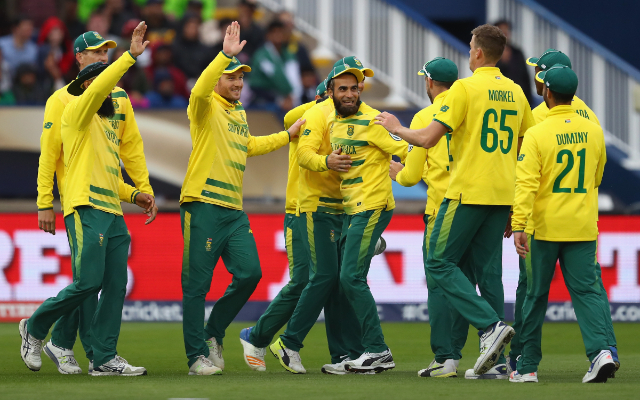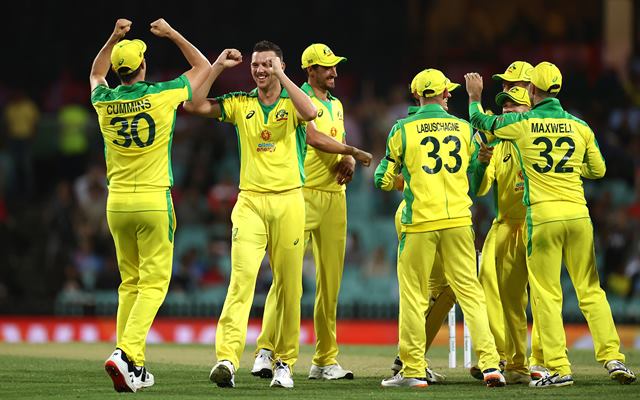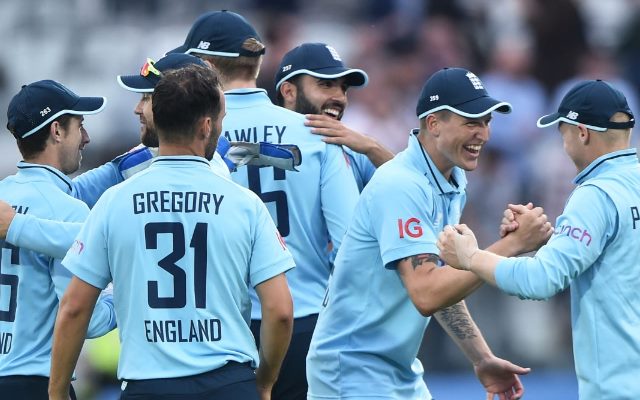Ranking top 5 second-string teams in international cricket currently
With several teams trying to develop their second-string sides, we try to rank each of these countries.
7 Min Read


NAPIER, NEW ZEALAND – JANUARY 23: Indian players celebrate during game one of the One Day International series between New Zealand and India at McLean Park on January 23, 2019 in Napier, New Zealand. (Photo by Kerry Marshall/Getty Images)
There has been a new culture that has developed in international cricket and the COVID-19 times has forced some boards to adopt it. Tt is the culture of strong bench strengths or having a pool of at least 25 or 30 players who are ready to represent the country. Some teams have already planned to schedule ODI and Test series simultaneously with different sides.
Last year, England fielded two separate sides in ODI and Tests during the English summer. India, this year, has already sent a 20-member squad to Sri Lanka for limited-overs series apart from 24 members to England for a Test tour. With most of the teams the following suit, it is a good time to look at the ranking of the second-string teams of each of these countries.
5. South Africa

South Africa‘s cricket system has gone through several issues for the past few years. The administration has been openly criticized while their problems have been well documented and highlighted in public. Their form and stature at the international level have also reduced significantly in the last few years and there have been worrying signs for the national team.
However, despite all of this, the country has not stopped producing good young talents. There are some really talented players waiting in the wings of the South African cricket system, who have been trained and groomed in the tough domestic cricket culture in the rainbow nation. After the likes of JP Duminy, Hashim Amla, AB de Villiers, and Imran Tahir retired, the country had players who could step in and fill the shoes.
The only problem being that these young stars don’t have leading senior players in the mix at this moment. If a second-string Proteas team is made today, then they might not be able to beat top-ranked sides but surely they would be able to face them with confidence. There has been work behind the scenes done on U-19 and South Africa A players, which always helps this situation.
4. Australia

There was a time in the 90s and early 2000s when Australian domestic first-class matches were sometimes more competitive than the Test matches. This was because Cricket Australia (then Australian Cricket Board) had made almost a factory of sorts that was capable of producing proper cricketers ready to go out and make a mark in international cricket. Australia A back then was as good as Australia.
However, after 2008, the slide of Australian cricket’s stature started happening. Today’s Australia is nothing like the dominant force it used to be back in Steve Waugh’s or Ricky Ponting’s reign, but yet they are a world-class team with some really talented players. The standards set by Big Bash League are quite high and the players coming out of that are very much ready.
The six-state team domestic structure has ensured that Cricket Australia can maintain a good standard of competitiveness in the country ensuring at any given point in time they have options to pick the top-level cricketers. Apart from this, there is obviously a good structure of bringing in players from grade cricket to the first-class system and there is a lot of work that has been done to develop U-19 and Australia A players.
3. New Zealand

Until a few months back, New Zealand was known as a fierce competitor and a country with a rich cricketing history that is ready to take some giant steps in world cricket. It all came down to the ICC World Test Championship final when the world witnessed that not only they are a force to reckon with, but are capable of world dominance.
New Zealand played three Tests in England recently, with probably the ICC WTC final being the only match where they played with their full-strength XI. Remarkably, after drawing the first Test against England in Lord’s, the Blackcaps made six changes for the Edgbaston game, which they eventually won.
When a country has a pool of batsmen, bowlers, and a couple of wicketkeepers and all-rounders to choose from, they can be considered a great team. This works because they can be without a particular player, but an equal can just slot in without disrupting their natural game. This is exactly what New Zealand Cricket has achieved in recent times, with an effective and competitive domestic structure that has only recently started incentivizing good performance at the domestic level.
2. England

England has really worked on their bench strength since 2015. The recent ODI series win over Pakistan was just a classic example of how deep they have gone and tried developing players. In limited-overs format, they have had England A or England Lions tour, where various players gain experience. On top of that, white-ball cricket has seen massive improvements even at the county level.
On the other hand, England has also tried to develop a secondary Test team. Even though their rotation policy has not always been effective, it has given much-needed experience to certain players, who can take these experiences and work on their game for a better career. If we leave aside the management of red-ball players, which to an extent has been a mess in recent times, the white-ball sides have done enough to stay on course with development in mind.
There have been large camps regularly being organized by the England and Wales Cricket Board (ECB) where county players are given close access to the international stars of the English. With this comes improved trainers and professionals looking after a player’s development. All these factors have helped England make a second-string side and also be ready to launch at any given time.
1. India

India is probably one of the few teams which can send their red-ball players to a long tour and still have some experienced players left with the white-ball squad. The squad which has been sent to Sri Lanka is by no means a second-string side and it still doesn’t have some players who might not end up in Test XI, but would be first-choice picks for ODI and T20I cricket.
The depiction of the power of the bench strength was seen in full flow when India won the historic Test series in Australia. That series win not only gave an example of India’s dominance in world cricket but also stamped authority of India’s great bench strength. The BCCI has over the years developed a system where players are groomed and nurtured from a young age. These kids are given all the necessary things to help them develop into quality international cricketers.
A system of Indian cricket has become such that you can be leading an IPL team, still not make it to the Indian team for even the T20 format. There has been a lot of focus given on the U-19 and India A structure and the right men have been put into the process of developing players. Rahul Dravid and the set of coaches and professionals who have worked alongside him have played a huge role in assuring that the future of Indian cricket is always in safe hands.
Download Our App